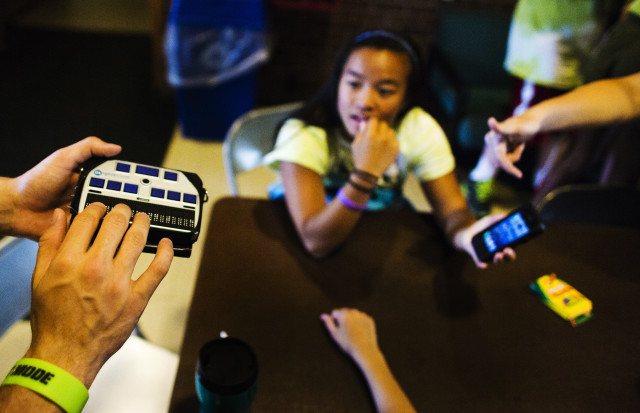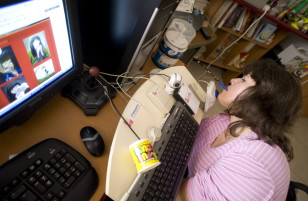
A child uses a Braille machine to type on his iPhone at Camp Abilities in Brockport, New York, June 25, 2013. (Reuters)
Progress over the past 25 years has made computing more accessible to people with disabilities. But from design to finish, accessibility is still an afterthought in the race to technological innovation.
Despite breakthroughs in robotics, speech recognition, eye-motion sensors, virtual reality and many other areas, the general design approach to new products still excludes people with disabilities.
Technologies often hit the market quickly because manufacturers are eager to get there ahead of the competition, said Aaron Steinfeld, Associate Research Professor at Carnegie-Mellon University’s Robotics Institute. As a result, “they often view the needs of people with disabilities as something to be addressed in the next version or a second iteration.”
But that might never happen, given rapid technological turnover and the meticulous, labor-intensive process of creating accessible products.
“Every piece of new technology requires that people think carefully about the different ways that people with disabilities both input and get their output from technology, whether it is mobile devices or websites or even virtual reality,” said Larry Goldberg, Director for Accessible Media at Yahoo. “None of it is automatic. Everything needs to be thought about carefully during the design and development process.”
He said cutting-edge technologies, in particular, “need the most attention in terms of inclusive design” because there are new apps, new websites and new services every day.

A visually impaired girl uses the computer at the Royal Academy for the Blind in Amman, Jordan, NOV. 22, 2011. (Reuters)
“If it is designed by people who aren’t aware of the special needs of people who are blind or mobility-impaired, there is a danger that it won’t be designed with every possible user in mind,” he said.
Amid the constant evolution of technology, developers are often too busy to update legacy websites. And they “don’t always follow best practices and guidelines on how to encode accessibility from the beginning,” said Steinfeld.
“Technology then becomes static over time,” he said. “And those websites exist over time. And yet nobody goes back to fix them and improve the accessibility of those systems. So you end up with a large collection of legacy systems that have accessibility problems that nobody is really available to address.”
A lot of progress has been made on the Web, on mobile platforms and in digital publishing to implement accessibility guidelines so that people with a wide range of disabilities are able to use the Internet effectively. But that only works if the content is created in a way that is cognizant of accessibility, said Jeff Bigham of the Human-Computer Interaction Institute at Carnegie-Mellon University.
The technology is there, he said, but part of the problem is convincing people that “creating usable software is vitally important.”
Accessibility is an important design consideration across all areas of technology development, said Judy Brewer of the Massachusetts Institute of Technology (MIT), Director of the Web Accessibility Initiative (WAI) at the World Wide Web Consortium (W3C).
“Newer technologies,” she added, “are increasingly being taken up rapidly in settings that people with disabilities want and need to participate in, such as education, the workplace, healthcare, commerce, social media and entertainment, where it is critical not to exclude people.”
Accommodating limitations in hearing, vision, dexterity, and cognition, for example, can only lead to broader usability and benefit. Neglecting that is a “disservice to the general population,” said Steinfeld.
That means creating technologies that work for everybody, rather than approaching accessibility as a niche market, so that a visually-impaired person, for example, can use Braille on the same websites others use.
“There’s this concept called Universal Design, which says that you should be designing a system to support a wide range of users, including people with disabilities,” said Steinfeld. “But you should do it in a way that has value and impact for the general population so that it becomes something that really has a positive impact on society as a whole rather than being a niche solution for a niche market.
Brewer said work is needed both on the design and product services level and on raising awareness among students, most of whom come into universities with little or no experience with disabled people. Often, they only become aware of the needs of the disabled when they get older or have increased exposure to disabilities.

Macedonian Roza Mojsovska, who suffers from a rare disease that heavily limits the movement of her limbs, works on a computer with a pen in her mouth while moving the mouse with her chin, Bansko, east of the capital Skopje, May 23, 2008. (Reuters)
Universities are producing “too many developers who don’t know about accessibility,” said Bigham, and need to focus more on that area of expertise because ultimately, accessibility isn’t only about technology.
“It’s also fundamentally about people,” he said. “Therefore, we need education programs that train people to be experts in both accessible technology and the people that use them.”
“It’s not in their mindset,” said Steinfeld.
“Being exposed to this in school where there are opportunities to learn and experiment … means that we’ll hopefully see a greater awareness going out into the workforce,” he said. “And that in turn will hopefully lead to more adoption of best practices.”
Steinfeld believes younger people, especially students, need “a little bit of extra attention so that they are in tune with these issues earlier on in their careers.”
This is why a new collaboration between the tech industry, the disabled community and academic institutions has sprung up.
Goldberg said the Teaching Accessibility initiative, in which Yahoo is a partner, aims “to make sure that students who graduate with degrees in computer science or design or development or human- computer interface get necessary training during higher education so that they emerge from their degree with knowledge and understanding of skills about how to design accessible technology for people with disabilities.”
“People with disabilities do come at every age. Whether you are temporarily disabled or whether you age into it, it’s a broad spectrum,” he said. “So the people we are hiring – yes, they are typically younger – and it’s important that at the very beginning of their careers, that they do understand what these design issues are about.”
It’s a long way ahead, particularly for the visually-impaired. And there are “real barriers still in place in many mainstream experiences.” he said. But he hopes the collaboration will help “narrow the gap for disabled people” so that that there are more successes and fewer failures, in the future.




